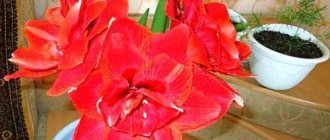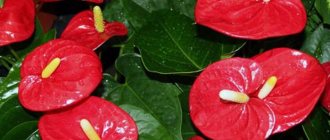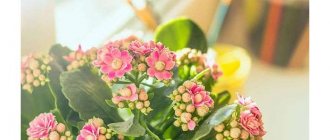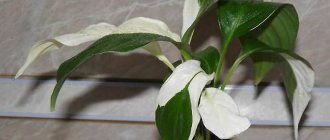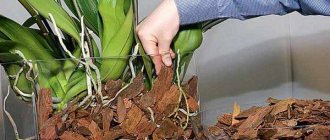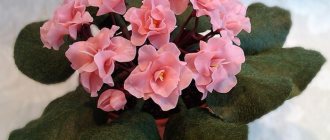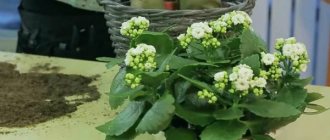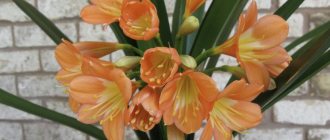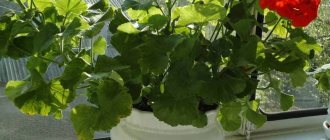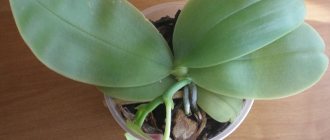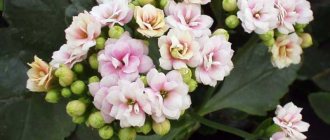What varieties of Kalanchoe bloom?
Kalanchoe, a common plant in Asia and Australia, can only be found in Russia at home. Unpretentious succulents with fleshy carved leaves, when properly cared for, decorate window sills with the bright colors of their inflorescences.
Kalanchoe has more than two hundred different varieties. Among them, the most popular are medicinal and flowering species. The bright, varied colors of the buds, the compact shape of the bush and multi-colored carved thick leaves attract the attention of amateur gardeners.
Depending on the variety, Kalanchoe has different forms of inflorescences, and the spectrum of their colors covers almost the entire color gamut, from snow-white to rich dark burgundy tones. The following varieties are considered the most popular for indoor cultivation:
- Mangina . It blooms at home with rich red or pink buds collected in large inflorescences. Leaning down, they resemble large bells. Mangina inflorescences are considered one of the largest among Kalanchoe.
- Kalandiva . A small bush throws out many small inflorescences. The abundance of bright double flowers and ease of care make it a favorite of many gardeners.
- Degremona . An interesting variety was brought from the island of Madagascar. It has unusual leaves that surprise with their structure and color. Has medicinal properties. Blooms with large, purple buds.
- Blossfeld . A low variety of the crop blooms with lush, bright red flowers hanging down. Each inflorescence consists of several dozen large flowers.
- Lucia . At first glance, a rather inconspicuous variety, when blooming, turns into a magnificent golden ball. After the last flower withers, the plant dies.
Reproduction of Kalanchoe
To propagate Kalanchoe, you can use cuttings, leaves and seeds. To make cuttings, it is enough to cut off part of the shoot or leaf and deepen it in the soil. After this, water the soil and cover it with film or a jar; roots will appear within 2-3 weeks.
If you manage to collect plant seeds, they can be planted in February or early March in a ready-made substrate. It is enough to distribute the seeds over the surface of the soil and press down a little, then cover with film or glass. Every day you need to ventilate the container and monitor the soil moisture. The cover can be removed after the seedlings are visible, which can eventually be transplanted into separate pots.
When does Kalanchoe usually bloom?
Kalanchoe, like many succulents, blooms once a year. It is important that it can bloom in winter, when there is little color and light around.
The plant pleases with its inflorescences for quite a long time. Usually buds form in January - February.
REFERENCE. At home, the culture blooms until mid-spring. Blooming Kalanchoe decorates the winter landscape outside the window.
Kalanchoe fertilizer
Growth, and especially flowering, always requires certain strength from the plant. To help Kalanchoe cope with energy loss, it needs to be fed periodically. You can use a complex with a universal composition if you don’t have a specialized fertilizer for succulents at hand.
Attention! If you use a general-purpose fertilizer, the dosage indicated in the instructions should be reduced by half; the frequency must be calculated independently.
When using fertilizers for succulents, you must follow the instructions exactly; the frequency of application should be no more than once a month. In the cold months of the year, there is no need to fertilize the plant at all; at this time it is in the resting phase.
Why doesn't Kalanchoe bloom?
When purchasing flowering varieties, you can often encounter the fact that the crop does not begin to bloom at home. There are many reasons that prevent bud formation, however, some of them play a key role in the process of laying future flowers.
Insufficient lighting
Kalanchoe may not bloom if the lighting conditions are disrupted. After flowering, during the dormant period, the plant requires good lighting. High-quality lighting affects the state of the crop. The leaves acquire a bright, rich color.
Before flowering, daylight hours should be reduced to 8 hours. Otherwise, it will not be possible to force the buds to form.
Incorrect temperature
Although Kalanchoe is considered an unpretentious crop, however, unfavorable temperatures do not allow flower buds to form.
The optimal temperature for Kalanchoe to bloom should not exceed 200C at night, and 270C during the day. During the dormant period in autumn, it is advisable to create cool conditions. The optimal temperature is considered to be not exceeding 170C.
There is no winter dormancy period
In order to make Kalanchoe bloom, it needs to create a period of rest. To do this, remove it to a cool, shaded place and reduce watering.
In such conditions, the flower is kept for 3 to 5 weeks. Then they return it to its place and begin to water it regularly.
Irrigation conditions are violated
Kalanchoe is a succulent. It has fleshy leaves that can accumulate moisture for future use.
Like any succulent, it’s better to under-water than over-water. However, regularly drying out a clod of soil in a pot at home does not allow the buds to form normally and leads to their shedding.
It is necessary to water when the top layer of soil dries out by 3-4 cm. Watering should ensure that the earthen clod is completely wet. The pot must have high-quality drainage, which protects the roots from stagnant moisture.
Presence of a draft
Kalanchoe can easily survive unfavorable conditions, but will not bloom. Drafts are one of the factors that reduce the likelihood of bud formation. When choosing a place for your green pet, you need to pay attention to the presence of random drafts.
Inappropriate soil
If a succulent is planted at home in nutritious and acidic soil, the development of buds will slow down or not occur at all.
REFERENCE. All succulents love light sandy mixtures with a neutral or slightly alkaline pH. It is important to fertilize in a timely manner. Their excess or deficiency will also lead to a lack of flowering.
Presence of diseases
A specimen affected by disease or pests devotes all its strength to survival. It most likely will not be able to bloom.
At the slightest suspicion of a disease, it is necessary to carry out treatment at home with special means. It is advisable to regularly spray Kalanchoe with insecticides against parasites and fungicides for diseases for prevention, without waiting for alarm signals.
Inappropriate humidity
Succulent leaves are designed to store water, which they get from the air. Therefore, humidity plays an important role in the well-being of Kalanchoe.
In dry rooms, it is advisable to place containers with water next to the pot. In hot weather, you can spray or rinse the flower in the shower. It is not advisable to spray in winter.
Big pot
It is not advisable to plant Kalanchoe in a large, empty pot. The presence of a large supply of soil provokes the development of a large number of leaves.
At the same time, it is almost impossible to force it to bloom. The pot must be purchased according to the size of the root system. It should exceed the root ball by 4 - 5 cm.
Kalanchoe stretches upward and just lets go of leaves
In the store, the plant resembles a small bush with carved leaves, the surface of which is strewn with half-opened buds. After some time, the process begins to decline, the crop stretches upward, and the leaf blades begin to fall off.
Kalanchoe blooming: care at home and reasons why it does not bloom
Why does indoor Kalanchoe stretch out and not bloom? There are two root causes for this behavior:
- lack of a dormant period - if the plant did not have a month’s respite after the development of buds, then it does not have time to form new buds;
- insufficient lighting - for any succulent, daylight hours should last at least 10 hours; its lack leads to deformation, thinning and increased fragility of the leaf plates, and damage to the stem.
When the first signs of insufficient light appear, the plant needs to install an additional light source and cut off shoots that have grown tall. After pruning, it is provided with complete rest; within one month, the density of the crown should recover on its own.
Important! Succulents do not tolerate direct sunlight on their leaf blades. Due to the large amount of moisture they contain, burns occur.
Kalanchoe stretching upward
Why a flower may not bloom, reasons
If Kalanchoe does not bloom for a long time, then the main reasons for this deviation include violation of maintenance rules. Inexperienced gardeners are confident that rare watering is sufficient for its normal development. But despite the prevailing opinion, it requires certain procedures to be followed.
Kalanchoe may refuse to form buds in a number of cases:
- violation of the temperature regime - attempts to keep it in a cold room affect the viability of the succulent;
- incorrect choice of lighting - lack or short daylight hours (less than 10 hours) leads to active growth of the green part, weakening and disease;
- insufficient or excessive soil moisture - plants prefer slightly dry soil, not swampy soil;
- lack or excess of fertilizers - a large amount of mineral solutions will provoke an increase in green mass, and their deficiency will cause slow growth;
Succulent folds leaves
- individual subspecies of the plant belong to the subgroup of annual hybrids - the question about life expectancy is asked to the seller before purchase;
- refusal of pruning - if it is not carried out, then with active vegetative growth the bush will lose its decorative shape;
- refusal of a rest period - after each formation of buds it requires rest for 3-4 weeks; if the rules are ignored, the buds do not have time to form;
- replanting is out of season - it is carried out only after the buds have withered, from the end of summer to the beginning of autumn;
- poor soil - succulents prefer loose soil with a neutral reaction; if the norms are violated, they refuse to grow and bloom.
Important! Diseases and parasitic insects rarely affect the crop. Kalanchoe copes with most of them on its own, but when infested by aphids, the flower requires outside help and treatment with insecticidal preparations.
Kalanchoe does not bloom and stretches out, what should I do?
Often, having purchased a flowering crop in a store, or received it as a gift, people are faced with the fact that it does not bloom again.
The branches stretch upward, the culture develops, but flower buds do not form. The main reason for this phenomenon is considered to be impaired light conditions.
In autumn, during the flowering period, natural light is not enough for the formation of buds.
You can help your green pet by providing additional lighting. To do this, turn on the lamps in the room in the morning and evening or illuminate the windowsill with stationary phytolamps.
This will force the Kalanchoe to form buds more actively.
Incorrect lighting and long daylight hours
Kalanchoe needs bright sunlight. In this case, the daylight hours for this plant should be no more than 8-9 hours. Therefore, in the middle zone it is almost impossible to achieve flowering in natural light.
In the summer, when there are many sunny days, daylight reaches 15-16 hours, but in winter, when it approaches normal, there is almost no sun.
If the Kalanchoe does not bloom and stretches out, you need to do the following:
- Keep the flower on a bright eastern windowsill so that it is exposed to the sun's rays in the morning;
- Limit daylight hours to 8-9 hours;
- In winter, when there is little sun, you can use artificial lighting lamps;
- If the plant does stretch out in winter, it is necessary to regularly carry out formative pruning of the bush, shortening its shoots to 10 cm.
How to make Kalanchoe bloom profusely if all conditions are right
Having provided good conditions for Kalanchoe, you can wait for the long-awaited flowering. And the use of additional techniques can make this flowering more abundant and lush at home.
- After the flower stalks fall off, Kalanchoe needs to be fed regularly. You can use ready-made mixtures for succulents and bearberries.
- About a month after flowering it is necessary to prune. Remove old and diseased shoots. Pinch off the growing points on young branches. Pruning allows you to shape the crown of the bush and prevents it from stretching. In addition, this will force the Kalanchoe to produce new flower stalks.
- Night temperature should not exceed 200C. Otherwise, the formation of flower buds may slow down, and the inflorescences will be few and far between.
- In autumn, in cloudy weather, it is advisable to use additional lighting to make the crop bloom.
Other possible causes and solutions
In addition to lighting, feeding and watering, the following factors also influence the ability of a plant to bloom:
- Soil composition;
- Content temperature;
- Air humidity;
- Diseases and pests.
The soil for planting Kalanchoe should not be too nutritious or poor. Excess, as well as lack of nutrients, has a bad effect on the plant’s ability to grow buds.
The best soil for succulents here is with the addition of coarse sand. There is no excess humus in such soil, but it is quite saturated with minerals.
And sand prevents soil caking and promotes moisture penetration to the roots.
Despite the fact that Kalanchoe is a resident of warm countries, it does not tolerate too high temperatures. The optimal range for it is 20-25°C in summer and 15-18°C in winter. During the rest period, the temperature can be reduced to 12-15, but not lower than 10°C.
Kalanchoe requires low air humidity . When it is over-moistened, fungal diseases develop, leading to the death of the plant. To achieve flowering, in addition to proper watering, you also need to keep the plant dry. Only under such conditions will it be possible to cause annual and sometimes repeated flowering.
Only healthy Kalanchoe can bloom. With any disease or pest damage, growing buds becomes impossible.
The plant is susceptible to root and stem rot. These fungal infections develop only with improper watering and high air humidity. Aphids and scale insects also settle on the flower. To maintain the health of the plant, it must be treated with insecticides to kill harmful insects.
Now you know why Kalanchoe does not bloom and grow upward, and what to do to correct care errors.
Rules for caring for Kalanchoe so that the flower blooms
In order for Kalanchoe to bloom, it is necessary not only to create good conditions, but also to properly care for it. High-quality care includes timely watering, replanting, pruning and fertilizing the flower at home.
- Watering . Kalanchoe loves water, but does not tolerate stagnation. Therefore, watering should be done no more than once a week. It should be quite abundant, but water should not accumulate in the soil.
- Transplant . In spring, it is better to replant faded Kalanchoe. To do this, select a pot that is 3-4 cm larger than the old one. You can plant Kalanchoe in a ready-made soil mixture for succulents or prepare the soil yourself. The soil must be neutral in acidity; sand is added to it.
- Feeding . Fertilizers at home are applied to the soil every month in the spring and summer. When using purchased products, you must strictly follow the dosage recommendations.
- Trimming . Flowering varieties of the crop require constant pruning. The main pruning is carried out after flowering, when the flower stalks are completely cut out and 2-3 lower leaves on the stems are removed. The tops of the shoots can be pinched, this will provoke the formation of side shoots. The bush will be more lush and bloom profusely.
Basic mistakes in flower care
If there is no formation of peduncles, or an unhealthy or weakened appearance, you need to check the standards for its content.
Incorrect lighting
Why does gloxinia not bloom at home?
Depending on the time of year, the crop requires different levels of light. During the growing season, it is sent to an eastern or western window. The south side is not suitable - due to constant exposure to direct sunlight, the bush not only slows down in development, but also gets burned. In bright sunshine, the windows must be shaded.
Important! During rest, it is better to artificially shade the plant: move it to a dark room or cover it with a box.
The determination of a sufficient level of lighting occurs when inspecting the greenery. If everything is in order, then there is a reddish border along the edges of the leaves; if there is a shortage, pale and elongated leaf plates are found.
Unsuitable soil composition
Plants sold in stores are planted in minimal containers, and the substrate is based on soil. Such land is not suitable for the normal development of bushes and requires replanting.
During the transplantation procedure, take a container of larger volume (2-3 cm), it must have drainage holes. Preference is given to a store-bought mixture intended for cacti and succulents.
Improper watering
The flowers do not require abundant watering - the procedure is carried out after the substrate has completely dried. Overwatering can become a source of disrupted metabolic processes, rotting of the root system, and fungal infections. Insufficient irrigation leads to yellowing and falling of leaf blades. A specimen that has survived drought will take a long time to recover.
Overflow is quite difficult to determine and this is the main problem. Symptoms appear after a long period of time due to the fact that primary negative processes initially affect the root system.
The damaged bush can be saved if it is dried in a timely manner and replanted in a fresh substrate. Before planting, the rotten parts of the roots are excised, and the cut sites are treated with a disinfectant.
Stem rot due to overwatering
Signs of crop overwatering include:
- the formation of yellowness on the leaves;
- pallor and lethargy of the plates;
- constantly wet substrate.
The volume of liquid for irrigation is selected in accordance with the temperature regime and season. During dormancy, the plant is practically not irrigated, the rest of the time - every week.
Important! In hot and dry weather, you need to wet clean the leaves by spraying or wiping with a wet cotton pad. During the process, make sure that water does not accumulate in the flower pot.
High or low room temperature
The optimal temperature for bud formation is +18..+29 degrees. Due to its subtropical origin, the succulent is not afraid of increased dry air and heat. The only problem is drafts; it should not be near air conditioners or open windows.
The culture can easily survive higher temperatures, but reducing it to 10 degrees can lead to damage to the green part. The only method of treatment is short pruning of shoots.
Important! Constantly high air humidity can become a source of activation of fungal pathologies.
Defeat by scale insects
Excessive feeding
A large amount of fertilizer provokes the active development of green mass and the absence of bud formation. The succulent needs feeding every 3-4 weeks, and during budding - twice a month. During annual hibernation, fertilizers are not applied.
For the procedure, store-bought solutions intended for cacti and succulents are used. They contain nitrogen, phosphorus and potassium elements. The mixture is added to the roots, avoiding its contact with shoots and inflorescences. Some gardeners advise diluting the composition with more liquid than indicated in the instructions.
The main signs of insufficient nutrient intake are:
- yellowness throughout the green part;
- darkening and deformation of the plates;
- loss of lower leaves;
- lack of budding.
Important! Too little or too much fertilizer is equally harmful. The correct approach to the problem requires sticking to the golden mean; emergency assistance is needed only when symptoms of hypovitaminosis appear.
Tips and Tricks
There are tricks, the use of which can make a flower bloom even when there is no hope left. To make the crop bloom, you need to follow these steps.
- A month before the expected flowering, you need to remove the plant to a cool, dark place.
- Stop feeding and watering the Kalanchoe.
- After a month, return the flower back to the room, avoiding places with direct sunlight.
- Resume watering the plant, after moistening it only by spraying for a week.
Stress will cause the plant to produce new shoots and set flower buds.
Why is it stretched out and there are no buds and what should I do to make it bloom?
In flower shops, buyers often give preference to blooming Kalanchoe, whose appearance is bright and attractive. In addition, it does not require much attention. Having purchased such a plant, everyone expects that it will bloom every season. However, after a long period of flowering, Kalanchoe no longer blooms, and the leaves become thinner. There are several main reasons for this problem:
- bad light;
- improper watering and temperature;
- wrong cut;
- lack or excess of fertilizers;
- lack of dormancy in the plant.
Mistakes in caring for Kalanchoe can be easily corrected by following some tips and recommendations.
Poor lighting at home
Kalanchoe needs certain lighting , the intensity of which must be adjusted depending on the season. From spring to autumn the plant is dormant, so lighting in the morning and afternoon should be maximum.
Important ! Kalanchoe should be protected from the scorching rays of the sun and hidden in the shade. Otherwise, thermal burns cannot be avoided.
In autumn and winter, natural light is in short supply, so there is no need to shade the plant. Moreover, if it is constantly cloudy outside, then you need to install additional lighting.
Whether a flower receives the correct lighting can be determined by the condition of its leaves.:
- bright and healthy leaves indicate that there is enough light;
- pale leaves signal a lack of light flux, while the stems become smaller and the shoots become elongated, flowering does not occur;
- dried whitish spots on the leaves are a burn, meaning an excess of light and heat.
In order for Kalanchoe to begin to delight with flowering, it needs to create daylight hours lasting up to 8 hours. Otherwise, buds will not appear. To make a Kalanchoe bloom, you need to hide it in a dark place, for example, in a closet until morning. If you follow these tips, flowering will definitely begin at the beginning of winter.
Kalanchoe blooms in about 11 weeks.
Incorrect watering and temperature
Kalanchoe makes its own reserves of moisture in its leaves, thanks to which periods of drought are easily tolerated. You should beware of excessive watering, which can cause root rot. Some rules for watering Kalanchoe that will ensure its lush flowering :
- The soil must be moistened generously so that the moisture soaks the soil, but excess must be removed.
- The earthen lump should have time to dry out between waterings.
- It is better for the plant to receive less water than more, as it copes well with no water for two to three days.
- In autumn and winter, Kalanchoe is watered half as often as on warm days. Under no circumstances should liquid be left in the tray. Water for irrigation must certainly be at room temperature.
The most comfortable temperature for Kalanchoe is +17-19 °C, but if the thermometer drops below, the plant will be fine. Since the flower loves fresh air, it can be placed on the balcony already at +10 °C.
Wrong cut
It is important to properly remove unnecessary leaves and faded parts, otherwise the plant will not develop and bloom. In addition, the edge gives the correct shape to the Kalanchoe.
In order for the plant to please the eye with abundant flowering, you need to wait until all the buds have bloomed before pruning. Peduncles are removed at the very base so that the plant does not begin to rot . This process stimulates the growth of stems that are ready to flower.
Trimming rules:
- Use a sharp knife in this case, and also reduce the amount of water when watering, and protect the plant from open sunlight.
- In the summer, be sure to pinch the top shoots so that the plant grows not only in height, but also in width. This way the Kalanchoe will acquire the correct proportions.
Pruning done at the right time will make the Kalanchoe attractive and bloom regularly.
Not enough fertilizer or too much fertilizer
Everyone knows that indoor plants, especially flowering ones, need feeding.
But in the case of Kalanchoe, it is important to maintain a balance, the violation of which will not allow the succulent to bloom. For feeding Kalanchoe, complex fertilizers are optimal, which contain the most important macro- and microelements. The ratio of the main components is as follows :
- nitrogen – 20%;
- phosphorus – 8%;
- potassium – 20%.
The fertilizer must be diluted in water; for this you need to dilute half a teaspoon in two liters of liquid. Fertilizer should be applied twice a month. At the end of summer, the amount of fertilizing is gradually reduced, and then completely stopped.
Attention ! After fertilizing Kalanchoe, it needs to be monitored, since if the leaves turn yellow, fertilizing should be stopped.
Fertilizers need to be applied regularly only during the period of active growth and flowering, after which their amount is reduced to once a month. During the dormant period of the plant and at an air temperature not exceeding +15 ° C, applying fertilizers is prohibited.
Lack of rest in a flowering plant
A common reason why Kalanchoe refuses to bloom. The fact is that after flowering the plant needs rest. To ensure peace after flowering, you need to cut off all flower stalks and move the pot to a dark and cool place with an air temperature of +15-17 ° C for a month. Watering should be done no more than once a week.
To force a succulent to bloom, seasoned gardeners advise giving the plant stress therapy. Its essence is as follows:
- Kalanchoe is placed in a cool, dark place for a month;
- watering is completely eliminated;
- after this, the flower is returned to its place and sprayed every day for a week, gradually restoring full watering.
Excellent results and rich flowering after this procedure are guaranteed.
Common mistakes
Often thinking that Kalanchoe is unpretentious, novice gardeners make a number of mistakes that prevent the plant from blooming.
- Excessive watering with stagnant water leads to rotting of the roots.
- Growing in a cold, ventilated window.
- Insufficient lighting intensity.
- Dry indoor climate.
- Lack of a dormant stage in the plant.
By eliminating such mistakes, you can easily make Kalanchoe bloom profusely and for a long time at home.
Incorrect watering mode
Very often, the flowering of Kalanchoe is prevented by improper watering regime. How to water this plant correctly? We should not forget that this flower is a succulent. It accumulates moisture reserves in its fleshy leaves and is adapted to drought and low air humidity. Water it regularly, but very moderately.
In summer, Kalanchoe should be watered so that the ground is moist but not wet. All excess water flowing into the pan must be drained so that it does not humidify the surrounding air.
Between waterings, the soil should dry out to at least 3 cm in depth. In winter, watering is reduced by 2 times.
Water the plant very carefully so that water does not get on the leaves and shoots. The slightest stagnation of water in the soil can cause rotting of the root system, and moisture on the leaves can cause stem rot. These diseases are difficult to detect immediately and develop gradually. A diseased plant does not bloom, then loses its leaves and dies.
Answers to frequently asked questions
Having purchased a Kalanchoe, many novice gardeners have a number of questions about how to care for it. Most often people are interested in the following problems.
What to do if Kalanchoe wilts?
Answer: Leaves of a crop can lose their elasticity in two cases. Severe water deficiency and disease. In the first case, it is enough to wet the roots of the plant well; in the second, treatment with medicines is necessary.
Why do you need to pinch the tops of the shoots?
Answer: Pinching the apical growing points will cause the shoots to branch. Namely, flower buds are laid at their ends. The more branches are formed, the richer the Kalanchoe will bloom.
Do I need to feed Kalanchoe when it blooms?
Answer: When the flower blooms, it is not recommended to feed it. Fertilizers are applied during the period of intensive development of green mass. This is spring or summer.
Diseases
Diseases of Kalanchoe are rare, but fungal infections still occur occasionally. Usually, an indoor flower can cope with the disease on its own if watering is reduced.
If the plant is severely infested, it can be helped by treating it with a fungicide and creating a gentle watering schedule. Since the soil can also be infected with a fungus, it needs to be completely changed, the root system inspected and dead parts removed. With the right approach, recovery will not take long.
If you pay attention to Kalanchoe, it is quite easy to understand the reason for the lack of flowering. By following certain recommendations, you can change the situation in your favor and wait for bright flowers to appear on your indoor plant.
Do I need to do anything after flowering?
After the Kalanchoe has bloomed, it needs some attention to itself. To stimulate the early appearance of new buds, it is necessary to carry out the following activities:
- Trimming . A faded plant needs to remove old and depleted peduncles. In addition, new shoots are pinched, and the outer ones are cut off at the root. This is done to rejuvenate the rosette and form a more lush bush. The process of forming a bush and growing greenery lasts until late autumn.
- Rest . After flowering, be sure to let the plant rest for a month in a dark place at a temperature of +15°C. In this case, watering should be very sparing during the entire dormant period (once every 2-3 weeks). After resting, it is necessary to return the plant to its original place and resume the previous watering regime - after a while new buds will appear.
- Annual transplant . It should be replanted in the spring, before it fully awakens after resting. To do this, pots with a diameter 2 cm larger than the previous ones are selected, and the substrate is changed to fresh, with a similar composition.
If you properly care for Kalanchoe during flowering and dormancy, and also create favorable conditions for its growth, this ornamental plant will certainly delight the owner with lush flowering.
